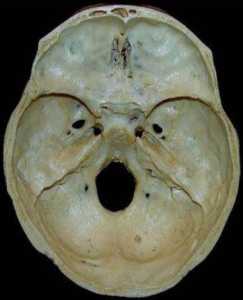

MedFriendly®


Basicranial
Basicranial means relating to the bottom of the skull
(sometimes referred to as the basicranium). The term is
sometimes used to refer to the location of a skull fracture at
the base of the skull although this is typically referred to as
a basilar skull fracture. A fracture in this region typically
involves the temporal bone (bones on the side and bottom
of the skull), occipital bone (bones on the back and bottom
of the skull), ethmoid bone, and/or sphenoid bone. The
ethmoid bone helps form the orbit (eye socket), separate
the nasal cavity from the brain, and forms part of the skull
base. The sphenoid bone is one of seven bones that forms
the orbit but also forms part of the skull base.
The base of the skull.
FEATURED BOOK: Neuroanatomy Through Clinical Cases
Basicranial may also be used to refer to brain tumors or other brain diseases located at
the base of the skull (within the brain tissue there). The curvature of the skull base is
known as basicranial flexion. The basicranial axis is an imaginary line from the groin to
the basion. The basion is the middle of a part of the occipital bone at the base of the
skull.
Basicranial comes from the Greek word "basis" meaning "foundation" and the Greek word
"kranion" meaning "skull." Put the words together and you have "skull foundation."
"Where Medical Information is Easy to Understand"™















